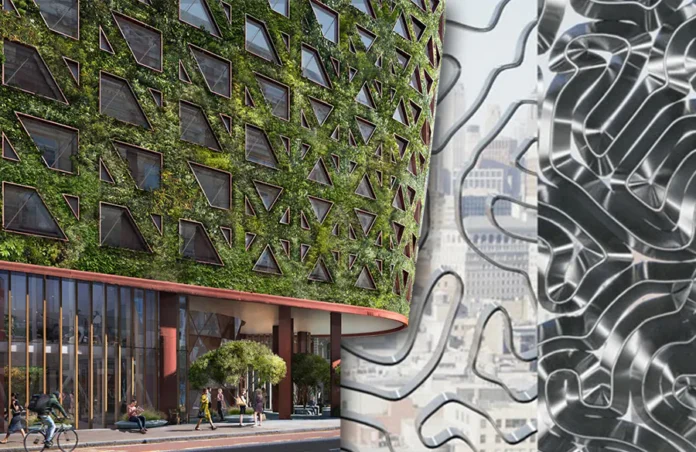The demand for facade design is rapidly increasing, transforming the architecture landscape. This surge is fueled by a blend of aesthetic aspirations, technological advancements, and environmental concerns. Facades now play an important role in defining a building’s identity, boosting energy efficiency, and incorporating cutting-edge innovations. The growing adaptation of facade design is driven by a combination of aesthetic, technological, regulatory, and market factors. As buildings continue to evolve in response to these influences, facade design is poised to play an even more integral role in the architecture of the future.
Why the demand?
- Unique and attractive facades help buildings stand out and enhance their visual appeal.
- Facades designed with energy-efficient materials and technologies reduce overall energy consumption and support environmental goals.
- Innovations in materials and construction techniques, such as smart glass, 3D printing, and prefabrication, enable more complex and efficient designs.
- The rise of high-rise buildings and complex structures in urban areas requires sophisticated facade solutions to ensure safety, functionality, and aesthetics.
- Stricter building codes and standards regarding energy efficiency and environmental impact drive the need for advanced facade systems.
- Distinctive facades can set properties apart in competitive real estate markets, attracting tenants, buyers, and investors.
- Facade designs must often balance modern needs with historical preservation, requiring specialized approaches that integrate with historical contexts.
Where are facades being used?
1. Commercial Buildings: Office towers, shopping malls, and mixed-use developments often use advanced facade designs to create iconic structures and enhance energy efficiency.
2. Residential Buildings: Apartment complexes and high-rise residential buildings utilize facades for aesthetic enhancement, privacy, and environmental control.
3. Educational Institutions: Schools and universities employ facade designs that not only provide visual appeal but also contribute to a conducive learning environment through natural lighting and effective insulation.
4. Healthcare Facilities: Hospitals and medical centers use specialized facades to manage solar gain, improve patient comfort, and ensure energy efficiency.
5. Cultural Buildings: Museums, concert halls, and libraries often feature innovative facades that reflect the building’s purpose and enhance its role as a cultural landmark.
6. Industrial Buildings: Even industrial facilities incorporate facade designs that improve energy efficiency and worker comfort, while also presenting a polished, professional appearance.
7. Public Transport Facilities: Airports, train stations, and bus terminals use facades to create welcoming spaces for passengers, improve natural lighting, and enhance thermal performance.
8. Sports Arenas: Stadiums and arenas often have dynamic facades that contribute to the excitement of the venue while providing practical benefits such as ventilation and crowd control.
Top 10 buildings in India with innovative facades
From government buildings to residential spaces and corporate offices, the contemporary Indian skyline is transforming, integrating both cultural heritage and modern engineering excellence. Here is an in-depth look at some iconic buildings across India that exemplify the fascinating evolution of facade design.
1. Krushi Bhawan, Odisha – A testament to local craftsmanship and sustainability, Krushi Bhawan, designed by Studio Lotus, stands as a government facility that bridges the gap between the state and its people. The facade, composed of a brick-louvered screen, mirrors the indigenous weaving patterns of the region and acts as an effective solar shading device. This design not only pays homage to the local artistry but also addresses the climatic needs by reducing heat gain, demonstrating how traditional elements can be reinterpreted in modern design.
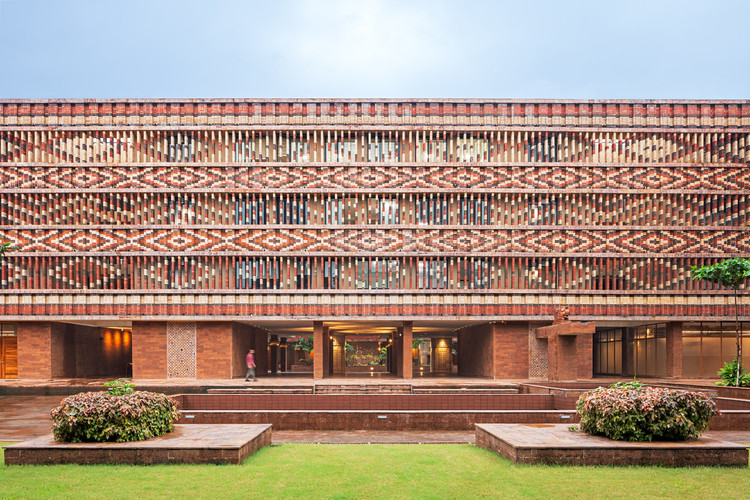
2. 72 Screens, Jaipur – In the heart of Rajasthan, 72 Screens by Sanjay Puri Architects encapsulates the essence of regional heritage through its innovative use of Jaali, a traditional architectural element. This office building is enveloped in a skin of folded plates made from Glass Fiber Reinforced Concrete (GFRC), which protects against the intense solar radiation typical of this region while providing an aesthetically pleasing, sculptural form.

3. Hexalace, Mohali – Studio Ardete’s approach to the open-plan commercial building, Hexalace, revolves around a hexagonal patterned, semi-permeable concrete facade that effectively shields the building from the harsh sun. The design incorporates a layered facade system that doubles as balcony fencing, optimizing both the building’s microclimate and its visual impact.
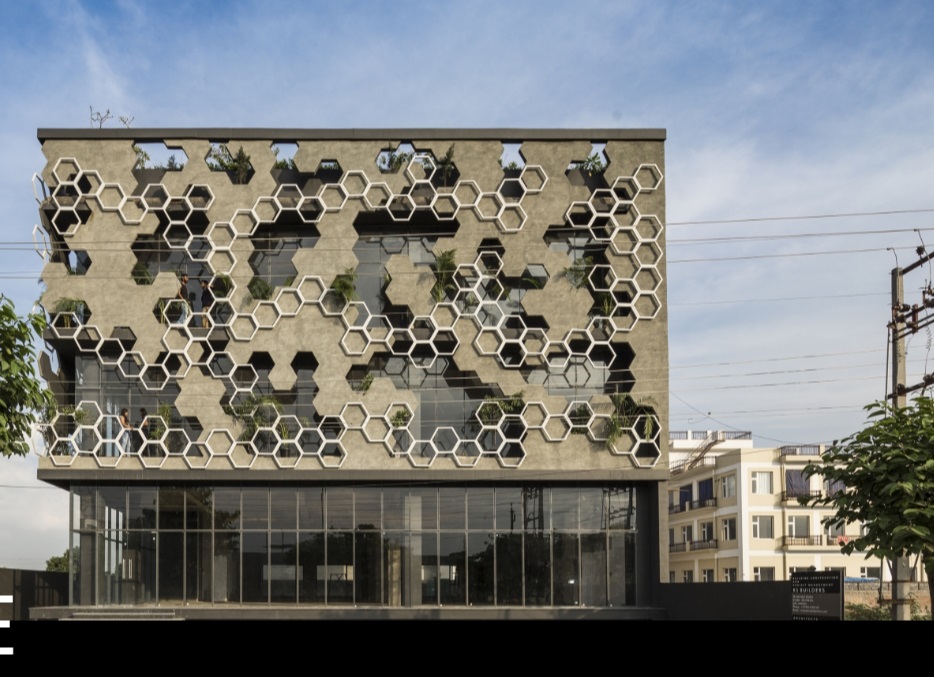
4. Temenos, New Delhi – The commercial complex Temenos, also designed by Studio Lotus, features a double-skin of perforated aluminum panels inspired by origami folds. The facade’s rich champagne color and carefully calibrated perforations strategically reduce solar glare and dampen urban noise, crafting a serene atmosphere within the bustling cityscape of Delhi.
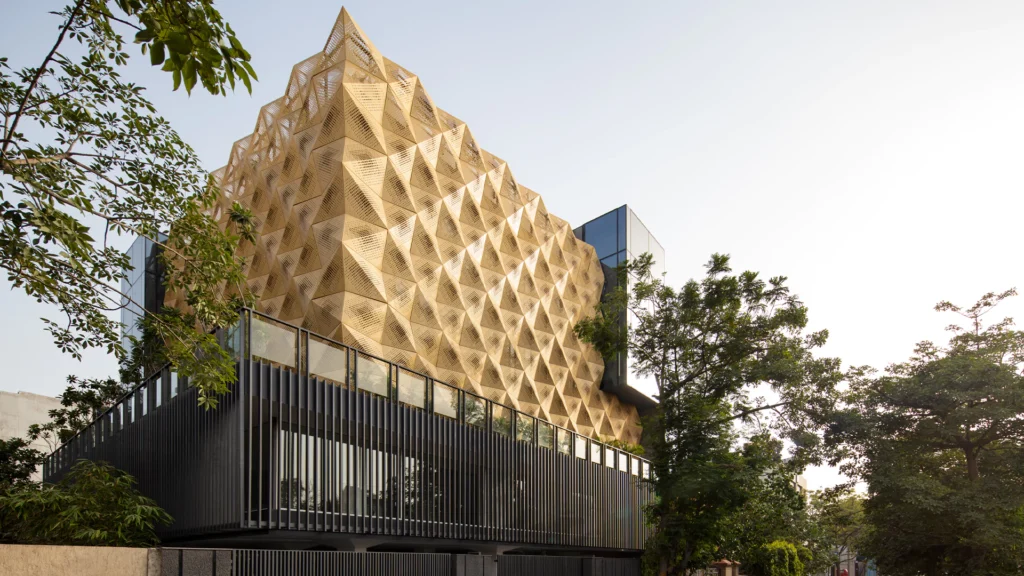
5. Hive House, Surat – Openideas Architects designed the Hive House with a focus on intelligent and sustainable living. The facade, influenced by the client’s involvement in the diamond machinery industry, integrates solar sensors within a geometric pattern reminiscent of natural hexagonal structures, illustrating how facade design can contribute to a building’s environmental responsiveness and energy efficiency.
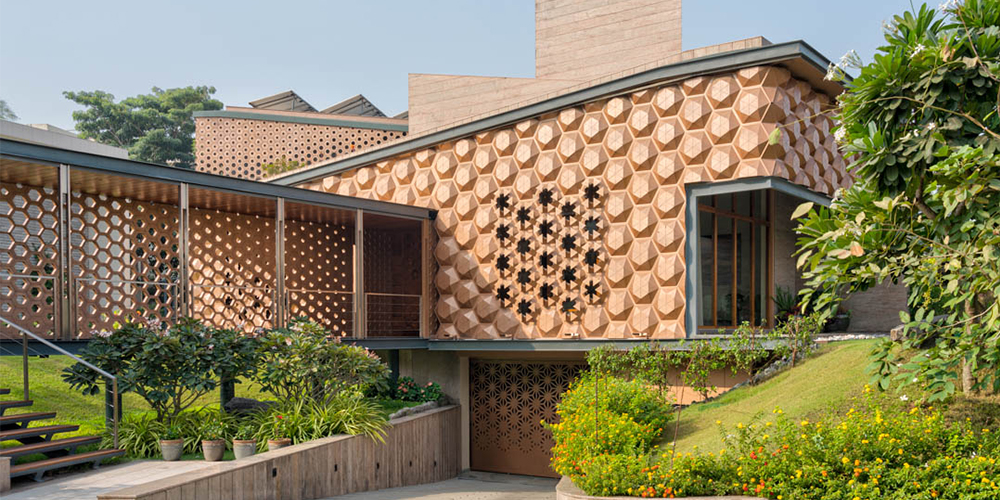
6. KMC Corporate Office, Hyderabad – The KMC Corporate Office uses a double-skin facade system that not only creates a dynamic visual exterior but also enhances the building’s climatic response. Designed by RMA, the facade includes a layer of hydroponic trays within the aluminum trellis that support vegetation, contributing to cooling through evapotranspiration and improving the building’s overall air quality.

7. Pearl Academy of Fashion, Jaipur – Morphogenesis reinterprets traditional Indo-Islamic architecture with modern passive cooling strategies in the design of the Pearl Academy of Fashion. The building features a double-skin Jaali that serves as a thermal buffer and is analytically placed to optimize shading and reduce direct heat gain, showcasing an effective blend of heritage and high-performance design.
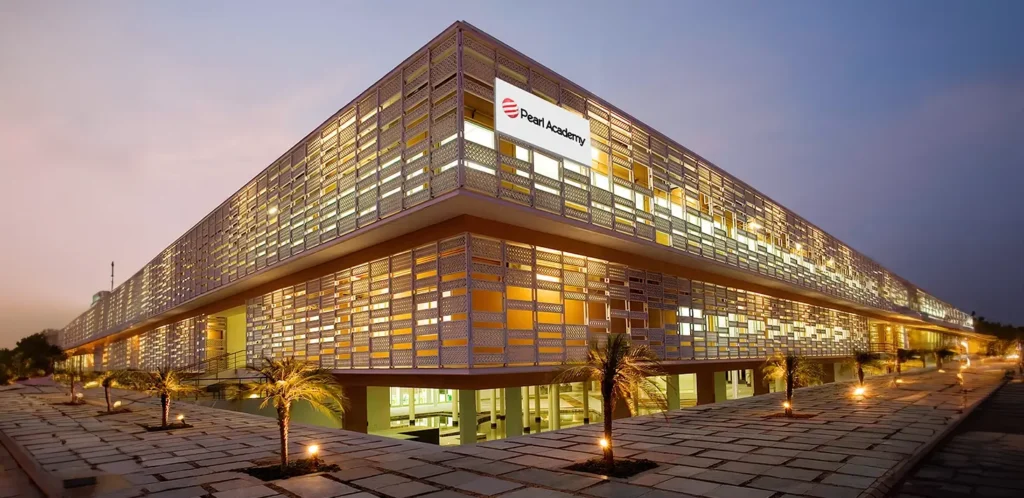
8. The Street, Mathura – The student housing complex known as The Street, designed by Sanjay Puri Architects, is oriented to maximize northern exposure, thus minimizing heat gain and enhancing the thermal comfort of its residents. Each room features a uniquely shaped bay window that further contributes to the building’s energy efficiency and distinct identity.
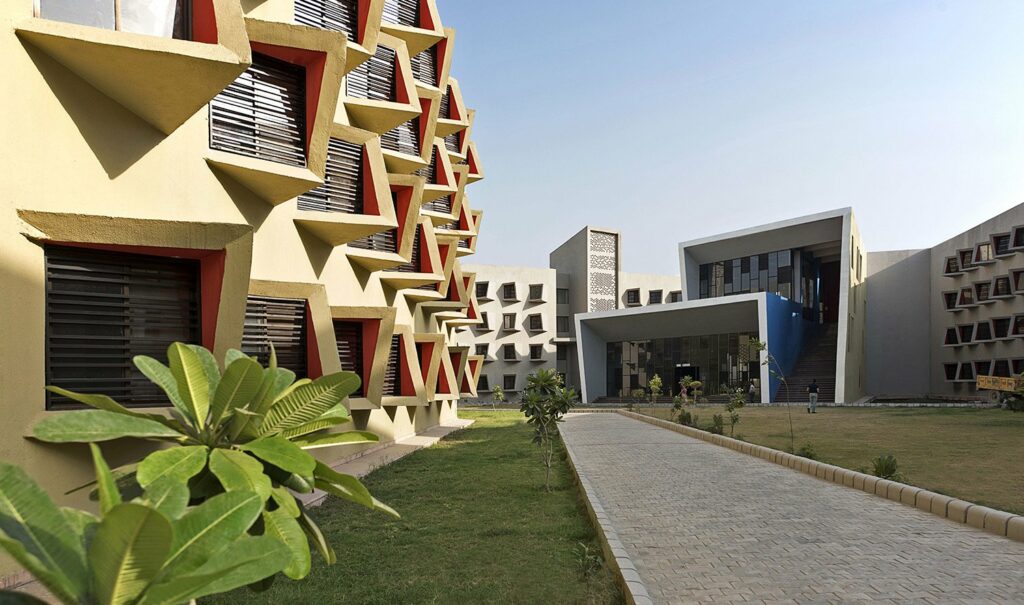
9. Cybertecture Egg, Mumbai – Breaking conventional architectural boundaries, the Cybertecture Egg by James Law Cybertecture International combines iconic design with advanced engineering. This office building utilizes a diagrid structure that supports a passive solar design, significantly reducing energy consumption while providing a futuristic aesthetic.
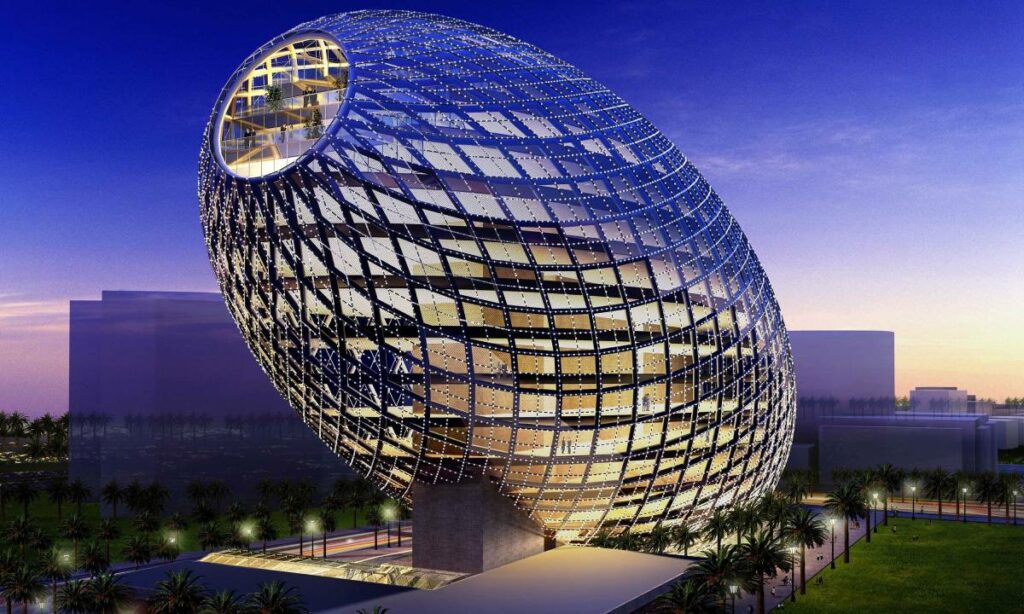
10. Moving Landscapes, Ahmedabad – Designed by Matharoo Associates for a real estate developer, this residential building showcases adaptable facades that transform with the touch of a button. The use of movable Bidaser stone panels allows the occupants to control light, ventilation, and privacy, exemplifying the potential of dynamic and responsive facade design.

11. Infosys Pune – Green Building, Pune The Infosys Pune campus features a remarkable façade that is recognized for its sustainability and innovative design. The building is designed to minimize environmental impact and maximize energy efficiency. The façade integrates photovoltaic panels and extensive greenery that not only reduce heat gain but also blend the structure with its surroundings. The use of dynamic glass that adapts to varying light conditions further enhances the energy efficiency of the building.

12. Lotus Tower, Mumbai- The Lotus Tower in Mumbai is inspired by the form of a blossoming lotus. This residential skyscraper features a series of overlapping petal-like structures that create a dynamic and sculptural exterior. These “petals” are not merely aesthetic but are designed to provide shade and reduce heat gain in the tropical climate of Mumbai. Each petal is clad in white composite panels that reflect the sun’s rays, aiding in the cooling of the apartments.

13. I-Flex Building, Bangalore- Designed by Morphogenesis, the I-Flex building is a commercial space known for its responsive façade system. The building is wrapped in a movable aluminum mesh screen that adjusts automatically to the sun’s position, controlling the amount of light and heat entering the building. This kinetic façade not only contributes to substantial energy savings but also provides a continually evolving exterior that reflects the dynamic nature of the technology company it houses.
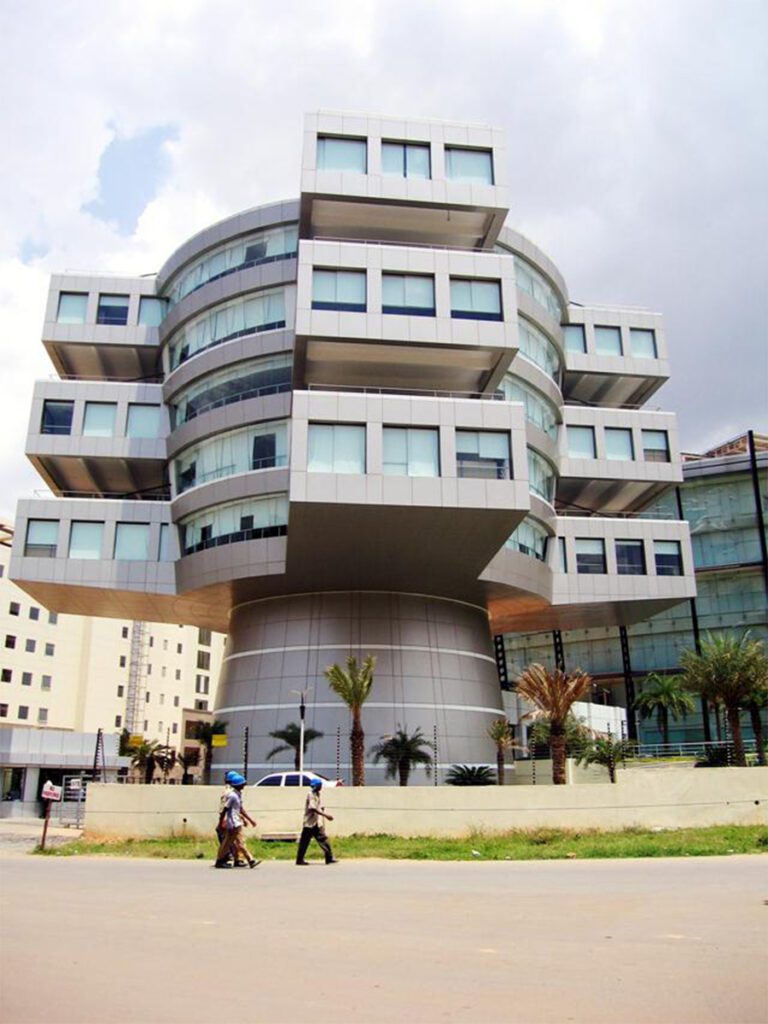
14. British Council, Delhi- The British Council building in Delhi, designed by Charles Correa, features a distinctive brise-soleil façade that consists of a series of concrete blocks forming a geometric pattern. This screen not only embellishes the building with shadow patterns created by the harsh Indian sun but also significantly reduces the cooling load by blocking direct sunlight. The façade blends traditional Indian elements with modern design, reflecting a cultural dialogue.
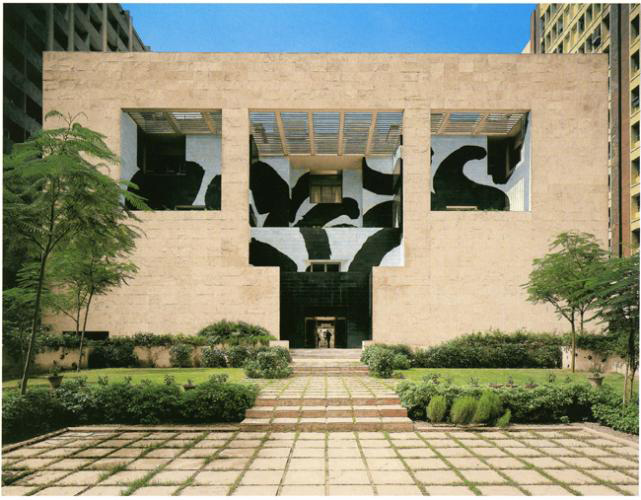
15. The Park Hotel, Hyderabad- The Park Hotel in Hyderabad is an epitome of modern design mingled with local artistry. Its façade is covered with a unique metal mesh that is both functional and decorative. This mesh is patterned with motifs inspired by the region’s traditional jewellery designs, creating a striking visual identity. The mesh not only serves as an aesthetic element but also as an effective environmental buffer, moderating the interior climate and protecting the interiors from the tropical sun while maintaining views.
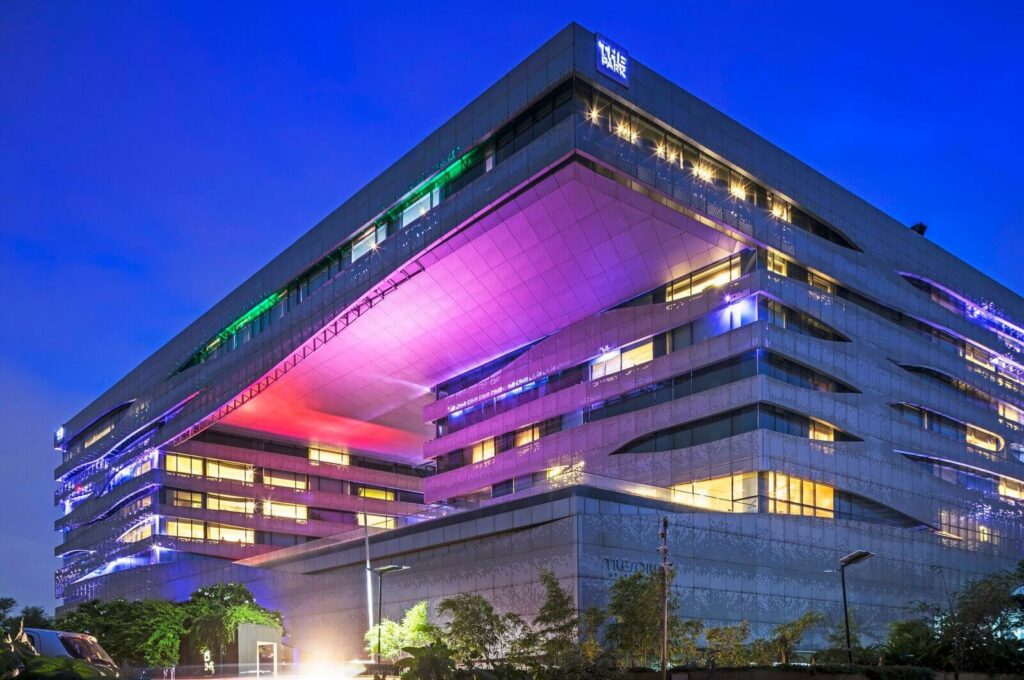
These buildings, like those in the original list, showcase the rich diversity of architectural innovation across India, blending aesthetics, sustainability, and local culture into their facades. Each building stands out for its unique approach to dealing with the climatic, cultural, and functional demands of its location.
Conclusion
The burgeoning trend of innovative facade design in India exemplifies a significant paradigm shift towards sustainability, technological integration, and cultural resonance in architecture. This evolution in facade architecture not only enriches the urban landscape but also sets a progressive course for future developments, promising a blend of ecological responsibility, cultural appreciation, and architectural excellence in the shaping of India’s urban future.
